Berlin Airlift, 70 Years Later
Use controls above or click here to open this Hometown Heroes podcast in a new window
91-year-old John Durant of Fresno, CA appears on episode #531 of Hometown Heroes, airing July 5-8, 2018. A Massachusetts native, Durant served with the 45th Air Depot Group in Europe during World War II, before embarking on a decades-long involvement in the U.S. space program.
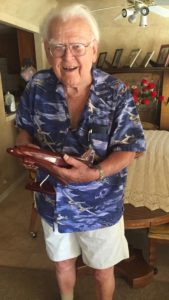
91-year-old John Durant. For more photos, visit the Hometown Heroes facebook page.
As people around the world mark the 70th anniversary of the Berlin Airlift – including another “Candy Bomber” reenactment by Gail Halvorsen, who shared his story on episode #404 of Hometown Heroes – we get perspective on that humanitarian triumph from someone who was involved in the airlift from start to finish.
“Young people have never heard of it,” John Durant says of the airlift. “It’s not in the history books at school. Unless they’ve heard from one of their older parents or relatives, they don’t even know what it is.”
Durant tries to change that by visiting schools and service clubs with a slideshow and speech that outlines the significance of that 15-month effort that included more than 277,000 flights to provide essential supplies to the people of West Berlin in 1948 and 1949. His path to Germany started in Boston, where he grew up enamored with model airplanes, and intrigued by ham radio. Those interests had converged on December 7, 1941, and he and some friends were about to launch a radio-controlled model airplane that they had constructed with a nine-foot wingspan. Concerned about crashing it and ruining the more than five pounds of radio equipment it carried, they got cold feet on that cold winter morning and headed to one of his friend’s ham radio shack. That’s when the news of the Japanese attack on Oahu made its way to their ears.
“We didn’t even know where Pearl Harbor was,” you’ll hear him recall.
That model airplane never flew again, but Durant would. His first solo flight came at age 16, and he still has the pilot’s license he was issued. At 17, he enlisted in the Army Air Corps, and after just a month of basic training in Biloxi, MS, he was headed overseas. Assigned to the 45th Air Depot Group in Charleville, France, he was immediately put to work changing spark plugs on P-51 Mustangs and P-47 Thunderbolts.
“That was half the night,” John says of that duty. “Guys get back at 4 o’clock in the afternoon, we’d work ’til midnight getting ’em ready for the next morning.”
He remembers their base getting bombed, even resulting in casualties, but he never feared that it would happen to him. The gravity of the situation would set in when pilots never made it home from their missions. “We lost P-51s. We lost P-47s,” you’ll hear him say. “That was hard to take.” After Germany surrendered, many of Durant’s friends were sent home, but his relative lack of points kept him there. The teenager was even put in charge of the base electric shop as the 45th moved from France to Germany. Some of the same Germans who had been working on Nazi planes in previous months were now teaming with the Americans. “We had them working on everything,” you’ll hear him explain. “We got along fine. The war’s over, we’ve got a job to do. Let’s do it.” Listen to Hometown Heroes for more of his post-war duties, his perspective on the German civilians with whom he interacted, and why he reacted emotionally upon seeing the B-29 Enola Gay on display outside Washington, D.C.
Why was Durant still in Germany in 1948 when the Berlin Airlift began? He extended his enlistment, then re-enlisted, for a very compelling reason. “I met a girl,” he says. “Finally we got married. We spent 66 years together, she just passed away 5 years ago. The most wonderful lady I ever met in my life.” The Durants already had the first of their two children by June 26, 1948, when the first flights carrying essential supplies made their way to Berlin.
“I was the scrounger,” Durant says of his initial role in the airlift. “I knew where all the stuff was.”
He spent countless hours tracking down different materials that were needed in a massive effort that would eventually deliver more than 1500 tons of food and 3500 tons of coal daily over the next 15 months. Durant points out that the nonstop nature of the airlift helped refine ground control approach technology and revolutionize aviation. It also gave tickled his airplane affinity when he found his name on a flight roster as a crew chief. “I didn’t have a place to sit, I sat on the floor, worked the flaps,” he recalls of the 147 flights in which he participated. They had weather to worry about, barrage balloons marking the boundaries of the narrow air corridors into West Berlin, and even Russian fighter planes harassing their relief flights. Bright lights in their eyes, radio interference, the MiG-3s did everything except fire on the American cargo planes.
“They never shot at us,” you’ll hear Durant explain. “That would start the war.”
With both the U.S. and the U.S.S.R. possessing nuclear technology, the onset of all out war would have carried catastrophic consequences. Instead, the uninterrupted logistical wizardry of the airlift (Operation Vittles), combined with the public relations coup of Operation Little Vittles and its “Candy Bombers,” pushed the Soviets to the point of calling off Berlin’s blockade.
“At that point the confidence of America in doing the right thing and winning was overwhelming,” Durant says. “Sadly, some of that stuff is being eroded today.”
John is proud of his role in the airlift and committed to keeping its history alive. He is thankful for the G.I. Bill, which paid for most of his college education and paved the way for his long career in the aerospace industry. At 91, he remains heavily involved with the Experimental Aircraft Association and the Aero Club of Southern California, hoping to pass on his love of flying to future generations. You’ll hear him share some memories from his association with the space program, working with Gemini, Apollo, and Space Shuttle missions, among others.
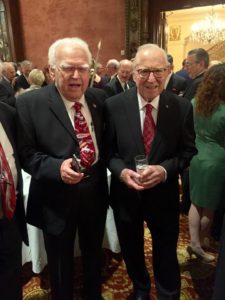
John Durant with famed astronaut Jim Lovell.
Listen to Hometown Heroes for the way he relates Neil Armstrong’s moon landing with high schoolers and their homework, and what John was doing on Christmas Eve, 1968, as astronauts Frank Borman, Bill Anders, and Jim Lovell became the first men to circle the moon. Unmistakable in Durant’s memories is the pride he takes in the achievements made in space exploration in the past 50 years.
“Someday we’re gonna go to the stars,” he declares. “I don’t know how. They’re light years away, but we’ll get there.”
That’s not the only thing Durant is looking forward to. He’s still hoping to find a ride in a P-51 Mustang. He worked on countless P-51s during World War II, but he’s never taken to the skies in one of those legendary fighter planes.
—Paul Loeffler

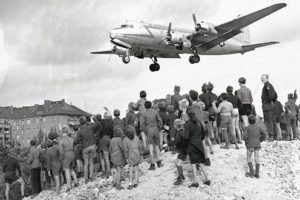
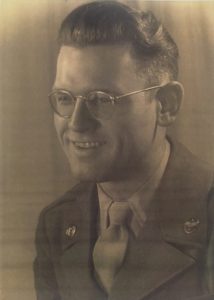
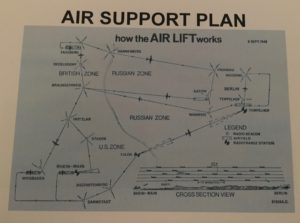
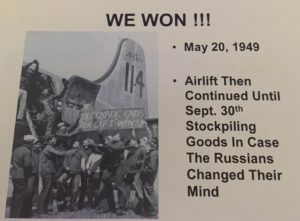
Love this truth about history!
John is a personal friend of mine. He has dedicated his life to aviation and space and I have attended many air shows with John. He has shared his knowledge with young people through the EAA Young Eagles program. He also serves on the Board of the Southern California Aero Club. A great guy.